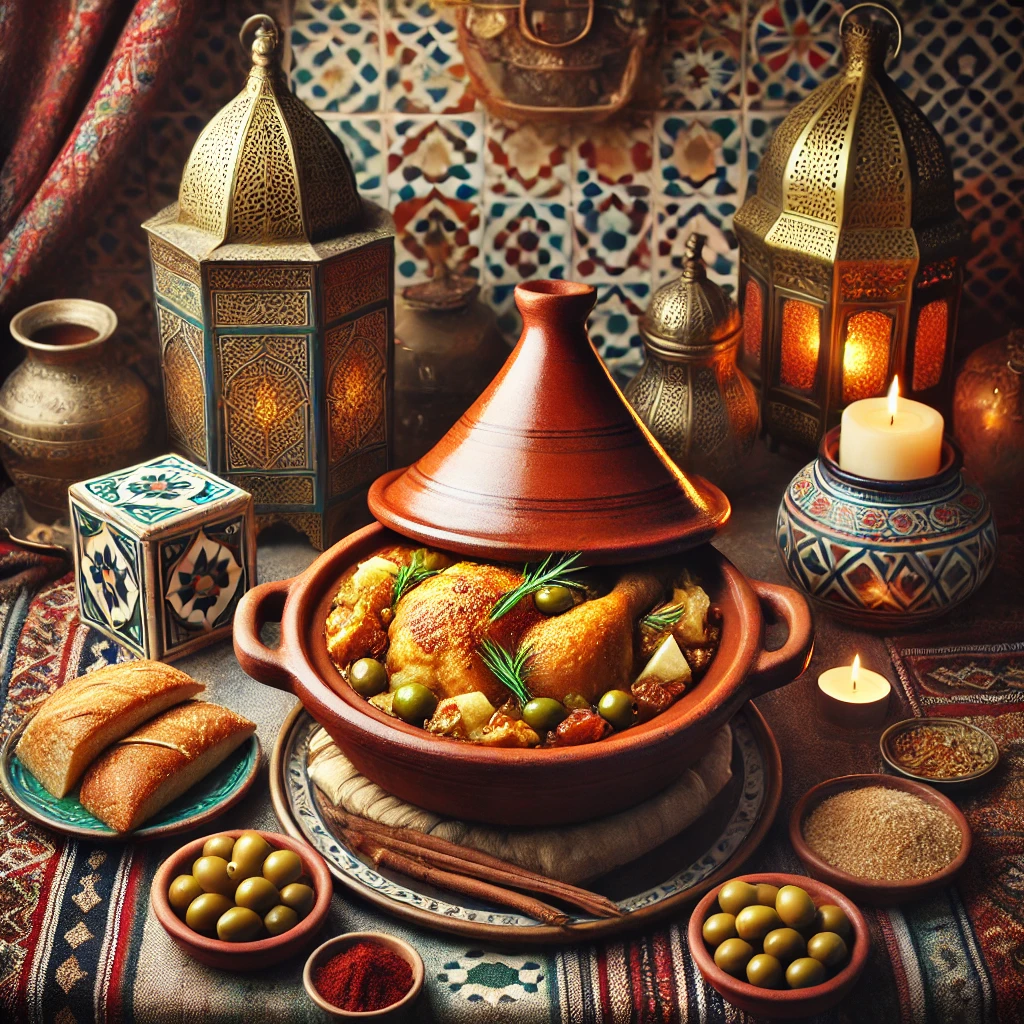1. Introduction to Moroccan Tagine with Chicken and Olives
The Moroccan tagine with chicken and olives is one of the most famous dishes in Moroccan cuisine, celebrated widely both inside and outside Morocco. This dish is known for its delicious taste and aromatic flavors, created using traditional ingredients and authentic Moroccan spices. The tagine is not just a meal; it’s a symbol of Moroccan tradition and is an essential dish served during special family gatherings and celebrations. It combines simplicity with sophistication, relying on basic ingredients but involving specific techniques to bring out the perfect flavor. In this article, we’ll explore the secrets of making Moroccan tagine with chicken and olives, along with essential details and insights about this dish.
2. Origins of the Moroccan Tagine and Its Cultural Significance
The tagine originated in Morocco and is believed to have existed for centuries, initially used in traditional cooking by the Berber tribes. The tagine is not only a cooking tool but also a cultural and heritage symbol of Morocco, becoming an integral part of daily life. The tagine is known for its unique clay pot with a conical lid that helps distribute heat and steam evenly during cooking, which gives the food a unique texture and flavor.
The tagine holds a special place in Moroccan celebrations such as weddings and family events, symbolizing Moroccan hospitality and representing family unity. The concept of “lemma,” or family gathering, is embodied in the tagine, as families and friends come together to share a delicious meal and good times around the table.
3. Ingredients of Moroccan Tagine with Chicken and Olives
To make Moroccan tagine with chicken and olives, we need a range of ingredients that lend the dish its unique Moroccan flavor. These ingredients are the essence of the taste and can be prepared in the traditional way for the best possible outcome.
- Chicken: Whole or cut chicken pieces, ideally using free-range chicken for a richer flavor.
- Olives: Moroccan green olives add a salty touch, balancing the overall taste of the tagine.
- Moroccan spices: Including turmeric, saffron, ginger, cumin, cinnamon, and paprika, these spices provide depth and harmony to the dish.
- Onions: Thinly sliced and used as the base, giving the dish a balanced, sweet flavor.
- Garlic and parsley: Garlic is added for a sharp taste, and parsley for garnish.
- Lemon juice and vegetable oil: Lemon juice enhances the flavor, while vegetable oil is used for sautéing.
4. Preparation Method
Initial Preparation:
- Prepare the Marinade: Mix turmeric, saffron, ginger, cumin, and salt in a small bowl. Add a little water to create a paste.
- Marinate the Chicken: Coat the chicken pieces with this marinade and let them soak up the flavors for 30 minutes.
Cooking Steps:
- Heat the Tagine: Place the tagine on low heat with a bit of vegetable oil.
- Sauté the Onions: Add the onions to the tagine and stir until they soften and turn golden.
- Add the Chicken: Place the marinated chicken in the tagine, turning it gently until both sides are browned.
- Add Olives and Lemon Juice: Once the chicken has partially cooked, add olives and lemon juice, then cover the tagine.
- Slow Cooking: Let the tagine cook on low heat for 40–50 minutes, allowing the flavors to meld together.
Flavor Enhancement Tips:
- Use the traditional clay tagine to slow-cook the dish.
- Add fresh herbs like coriander after cooking to enhance the flavor.

Moroccan Tagine with Chicken and Olives
5. Health Benefits of Moroccan Tagine with Chicken and Olives
Moroccan tagine with chicken and olives is rich in nutritious ingredients, making it a healthy option. Here are some of the health benefits:
- Chicken: A great source of protein and low in fat, making it beneficial for muscle and bone health.
- Olives: Contain healthy fats that improve heart health and reduce inflammation.
- Spices: Such as turmeric and ginger, which have antioxidants that boost the immune system.
- Cooking Method: Tagine cooking relies on slow cooking, preserving nutrients and reducing vitamin and mineral loss.
6. Variations and Flavors for Moroccan Tagine
You can add different twists to the Moroccan tagine to suit various tastes. Some popular variations include:
- Tagine with Chicken and Pickled Lemon: Adding pickled lemon for a tangy, bold flavor.
- Tagine with Chicken and Vegetables: Using seasonal vegetables like potatoes, carrots, and pumpkin.
- Tagine with Chicken and Chickpeas: Adding boiled chickpeas for extra protein.
7. Serving the Moroccan Tagine in the Traditional Way
The tagine is traditionally served with Moroccan bread known as “msmen” or “khobz beldi” (traditional Moroccan bread). Eating it with bread makes for a unique experience. It’s preferable to serve it directly in the tagine to keep it warm and preserve its flavors. You can garnish it with fresh herbs like parsley or coriander and serve olives on the side.
8. Conclusion
The Moroccan tagine with chicken and olives is a dish that combines simplicity with rich flavors, embodying the authenticity and tradition of Moroccan cuisine. This dish is a healthy and tasty option that everyone can enjoy at home. We hope you enjoy preparing and serving it as a delightful meal for your family and friends.

